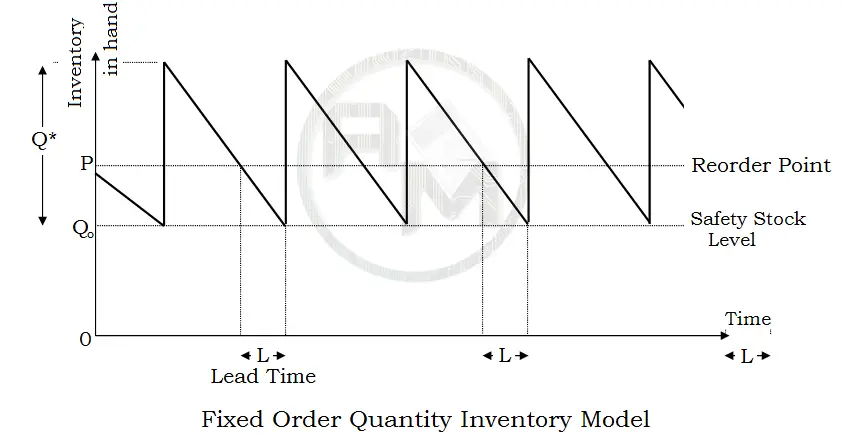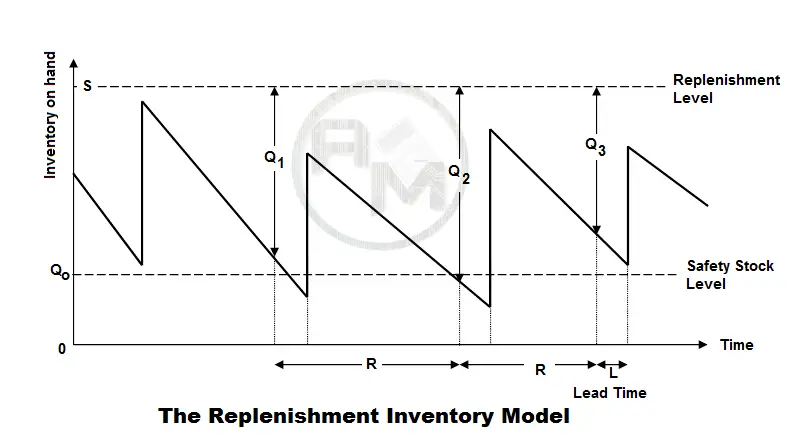Inventory generally refers to the materials in stock. Inventories represent those items that are either stocked for sale or they are in the process of manufacturing or they are in the form of materials, which are yet to be utilized.
It is a necessary production module of the Production planning process and Operation Management to hold various kinds of inventories as a buffer between supply and demand for the efficient operation of the system. Thus, effective inventory management is a must for the smooth and efficient running of the production cycle with fewer interruptions.</ahref=”https:>
From Raw materials to final products, Inventories may be divided in three following ways:
- Raw materials inventory
- work-in-process (WIP) inventory
- Finished-product inventory
Thus inventories play essential roles as buffer stocks for smooth, flexible material flow, and to generate time utility. Inventory management is very important to ensure an adequate supply of products to customers and avoid shortages as far as possible.
Role of Inventory
Finished-product inventory absorbs the difference between the individual activities of production and marketing. It enables shipping of products on time according to the customers’ orders and wants, while, on the other hand, setting the manufacturing system for its stable and optimum utilization.
Another utilization of the inventory function is in the parts-oriented production system. This system actively uses the parts inventory, which plays a more important role than just storage of parts as in other manufacturing systems.
Reasons for Keeping Inventories
There are a lot of reasons for keeping inventories such as the following:
-
For Smooth production operations
The inventories (raw materials and components) should always available to the production otherwise the production stoppage takes place for want of materials. Hence, the inventory is kept to take care of this unwanted hurdle so that the production is smooth.
-
To meet the demand during the replenishment period
Inventory is maintained to meet the demand during the procurement or replenishment period. Since, procurement time depends upon many factors such as materials source-location, demand-supply condition, etc.
-
To take advantage of price discounts
Usually, many manufacturers offer a discount for bulk buying of materials or components. Thus, inventory is also maintained to take good price discounts.
- Seasonal availability of materials or a sudden increase in prices
What is Inventory Management?
Inventory management is a planning approach of determining what to order when to order and how much to order and how much to stock so that costs associated with buying and storing are optimal without interrupting production and sales.
Inventory management basically deals with three problems:
- When should an order be placed? (Order level)
- How much should be ordered? (Order quantity)
- Where should an order be placed? ( Material Source)
The Inventory Management system keeps the balance between the loss due to the non-availability of an item and the cost of carrying the stock of an item. Inventory management aims at maintaining the optimum level of stock of raw material required by the factory at a minimum cost to the company.
Objectives of Inventory Management
Objectives of Inventory management are as follows:
- Investment in inventories must be minimum.
- To maintain records of inventories of all the items and to maintain the stock in sufficient quantity.
- Efficient purchasing, storing, consumption and accounting for materials
- To ensure timely action for replenishment.
- To provide a scientific base for both short-term and long-term planning of materials.
Practical inventory policies
Two-bin system. The items are stored in two equal-sized bins. The demands are filled by one of the bins; when it becomes empty, the other bin is employed and parts are procured to fill the empty bin, e.g. inexpensive fasteners stocked in bulk in a two-bin system and on the free issue to production.
ABC inventory classification (or analysis). In ABC inventory analysis, the classification of existing inventory is based on annual consumption and the annual value of the items. It is common that 5-20% of inventory items incur 50-60% of the inventory expense; these items are called ‘A-items’, and stock-leads are controlled accurately. ‘B-items’ typically account for 25% of the remaining inventory expense and represent 30-50% of the entire items. The remaining ‘C-items’ are of low cost, and control of their inventory is relaxed.
Inventory Functions in Manufacturing
inventory’ plays the role of buffer— stock — in the material f l o w from the acquisition of raw materials to the finishing of products. Inventory management/control is made so as to:
- Reduce inventory costs
- Stabilize the production level
- Increase the service level by preventing product shortages to customers
Fundamentals of Inventory Analysis
In an inventory analysis, an attempt is usually made to minimize the total costs incurred such as:
- Acquisition of production cost;
- Inventory-carrying cost;
- The penalty associated with shortages, etc.
Basic decision factors for attaining these aims of inventory analysis are as follows:
- Reorder date (or point) P, and
- Reorder quantity Q.
Inventory Models
The states of the above two factors produce various inventory models:
The Fixed-Order Quantity System Or The Wilson model
the most basic, classical model wherein the economic order quantity Q* which minimizes the total variable costs of managing inventory is optimally determined and this quantity is ordered whenever the inventory on hand drops to a particular level, referred to as the reorder point. Hence P varies.
Economic Order Quantity for Fixed-order Quantity Inventory Systems
The economic order quantity (E O Q ), which plays a fundamental role in the fixed-order quantity inventory system, minimizes the cost of managing inventory. In determining this quantity the model assumes that the cost is made up solely of two components:
- ordering cost;
- carrying cost.
Hence the objective function is formulated:
U = Co(D/Q) + Ch(Q/2)
where Co is the cost of placing an order, Ch is the annual carrying cost per unit of inventory, and D is annual sales or demand in units (uniform distribution).
Ch is often expressed as:
Ch = Cp•r
where Ch is the unit purchase or production cost of an item and r is the carrying cost expressed as an annual percentage of this unit cost— annual inventory-carrying charge.
Then the Economic Order Quantity is obtained by differentiating equation ” U = Co(D/Q) + Ch(Q/2)” and setting it equal to zero:
Q* = √ 2•Co•(D/Ch)
As in the case of the economic lot size, it is usual that the inventory-cost curve is shallow near this EOQ; hence it is relatively insensitive to deviations from the EOQ.
In this model, the number of reorders a year is:
n= D/Q* = Ch•(D/2Co)
and the minimum annual cost is:
U* = √(2Co•Ch•D)
Reorder Point
The reorder point P is the point at which to reorder the above quantity Q*. It is made up of the average expected sales during the lead time— the time lag between placing and fulfilment of a reorder— and the safety stock preventing a temporary out-of-stock condition which would lead to late deliveries and probably result in lost sales as follows:
P = Qo + dbarL
where bar is the average daily sales in units, L is the lead time in days, and
Qo is safety stock in units, and is given by:
Qo = θa•σd•√(L)
where σd is the standard deviation for daily sales and θa is the reliability level for satisfying demands, e.g. d0 95 = 1.65 for satisfying 95% of demands.
s.
The Replenishment System
In the replenishment system, there is no fixed reorder quantity; instead, inventory is viewed at periodic intervals, and if there have been any sales since the last review, an order is placed. The order quantity is equal to the amount by which a fixed replenishment level exceeds the actual inventory level at the time of the review.
The replenishment level is determined by:
S = Qo + dbar(L + R)
where Qo = θad √(L + R) , and R is time between reviews in days.
The reorder quantity is:
Q = S-I , if L ≤ R
= S-I-Qτ , if L > R
where I is inventory on hand at time of review in units, and Qτ is quantity on order in units.
The replenishment inventory system is effective in many real inventory situations, particularly when delivery lead times are long and shortage costs are extremely high or when stock counts are infrequent

The (S, s) system:
The (S, s) system is defined as a policy which generates an order when the inventory level falls to a prescribed value. In this model, by determining the reorder level corresponding to S = Qo + dbarL
as:
S = Qo + dbar(L + R/2)
along with the replenishment level S given by S = Qo + dbar(L + R), at each review of order for Q = S – I – Qr units is placed only when (I + Qr) < s . Thus the inventory on hand plus that on order never exceeds S.
The (S, s) policy responds more quickly to changes in demand values than other models
Shortage Loss Inventory Model
If reorder (back-order) is allowed to meet the shortage incurred by the excess demand, the optimum EOQ can be determined so as to minimize the annual variable cost consisting of;
- Ordering cost,
- Inventory-carrying cost
- Shortage loss
Hence the objective function to be minimized is:
Us = co• (D/Qs) + cs(Qs – Ps)2/2Qs + ch • (P2s/2Qs)
where cs is the annual opportunity loss incurred by shortages of the unit product, Qs is the order quantity, and Ps is the reorder level.
The inventory and the reorder level are obtained by partially differentiating above equation with respect to Qs and Ps and setting them at Zero:
Q* = √(2co • D)/ch • √(cs + ch)/cs
P*s = csQ*s / (cs + ch) = √(2coD)/ch √cs/(cs + ch)
In the inventory model with shortage loss, the average service level is given by:
s1 = P*s/ Q*s = cs/(cs + ch)
Conclusion
Inventory is built and used to satisfy multiple reasons. Products can be produced and stored when demand is low to satisfy demand in periods where it exceeds the production capacity. If set-up cost is high, production in large lots may reduce production cost as set-up cost is spread over a large number of units, but will also create inventory that must be stored.
Although, Keeping inventory is expensive. Industries need storage space, some amount of money is invested in the inventory, and there are carrying and maintenance costs, So efficient Inventory management is a must for every manufacturing industry.

